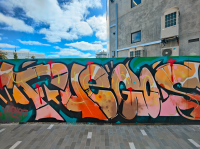
Throughout 2022, I have been working with Tāmaki Makaurau researcher and artist Dr Bobby Hung (perhaps better known under his graffiti pseudonym, Berst, a highly respected artist, advocate and documentarian) on a project to record a series of oral histories of Aotearoa graffiti artists.
With funding from the Manatū Taonga Ministry of Culture and Heritage’s Nga Korero Tuku Iho New Zealand Oral History Grant, we have conducted interviews with graffiti writers from across Aotearoa, recording in depth conversations about their experiences, motivations, influences, aspirations and philosophies (admittedly several participants baulked at the idea of a ‘graffiti philosophy’). The interview subjects span generations and hail from across the country, many living in various cities and countries over time, providing insights into different time periods, physical and social environments and evolving stylistic trends.
The conversations have provided a fascinating opportunity to reflect on the unique nature of graffiti writing as an art movement unlike any other; often impressive, equally infuriating, massively contradictory and ultimately honest. Graffiti is a truly difficult artistic culture to frame. It is both creative and destructive. For many, it is inexcusable, a flagrant, and largely illegal, with a disrespect for private property, and as such societal expectations.
And yet, these conversations have reaffirmed a more complex reality, a reality that marries dissent and rebellion with creative drive and community. For most, the initial attraction of graffiti was creative, the recognition of a bold visual outlet for their artistic talent that was more fitting stylistically than other, more ‘accepted’ channels. Graffiti unlocked a belief that they had found something at which they could excel. From this initial spark, a new world was unlocked, one often involving mentorship, inspiration and friendship, where they were pushed and expected to improve and understand the histories and trajectories of the subculture.
Whilst there have been shared experiences, it quickly became apparent that graffiti culture is filled with diverse voices and experiences. Whilst graffiti remains a male-dominated subculture, there are a wide variety of backgrounds and profiles amongst participants. Our interview subjects have come from various cultural backgrounds and diverse life experiences. Many had used graffiti as a platform for creativity; designers, tattoo artists, visual artists, musicians and DJs. Others worked jobs in social services, education or trades. Some are married, some parents; some both, others neither. A number were well travelled, sometimes as a result of graffiti connections, although not exclusively. While some artists were now less active, they recalled the way graffiti defined periods of their life, fondly recalling different eras, as far back as the mid-1990s, informed by key social environments and events.
The intentions and motivations behind their graffiti were equally diverse. Some explained that they saw graffiti as a pathway to changing their environment, dreaming of colourful, vibrant cityscapes. Others suggested their graffiti was borne out of a less positive energy, either a release of frustration or a chance to be delivered from the mundane. For multiple artists, graffiti was an unshakeable compulsion, a way to create and leave a legacy of their presence.
A common response at the end of the interviews was appreciation of the chance to reflect and share their stories. Participants acknowledged the need for such platforms, to encourage understanding about graffiti and why it has endured through multiple generations and spanned countless locations. One artist wondered why so much discussion by authority and the media focussed on the act of eradicating graffiti once it manifested, and not the reasons people are compelled to produce it. Ultimately, graffiti will remain a difficult proposition, however, these conversations have revealed the reality that often those most eloquent in discussing the culture are those producing it.
IMAGE
- A traditional graffiti piece by North Island artist Fuego, painted for the Flare Street Art Festival Graffiti Jam in March 2022
